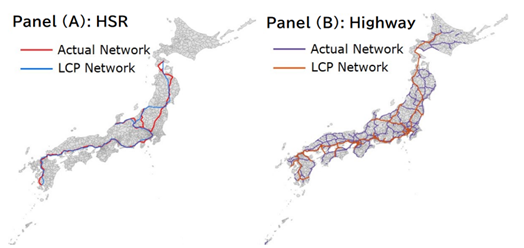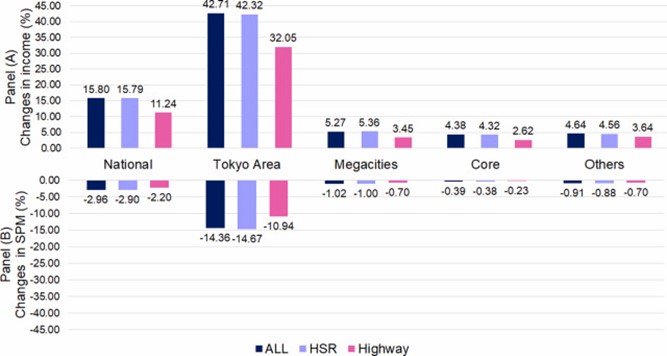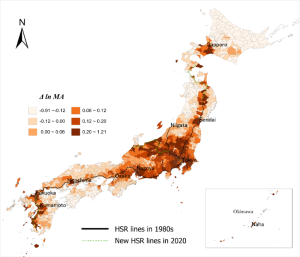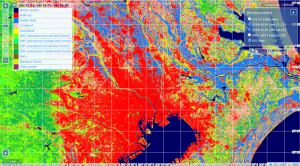

Applications
2024.01.15 Mon
The Use of Earth Observation Satellite Data in the Humanities and Social Sciences (2)
This series introduces research using Earth observation data by experts in socioeconomics and other fields. The second article will focus on the economic and air pollution effects caused by transportation infrastructure expansion. Same as the first article, this research is conducted with Managi Laboratory, Graduate School of Engineering, Kyushu University.
Economic and Air Pollution Disparities: Insights from Transportation Infrastructure Expansion
Authors: Sunbin Yoo1, Junya Kumagai2, Kohei Kawasaki1, Sungwan Hong3, Bingqi Zhang1, Shunsuke Managi1 (1 Kyushu University, Faculty of Engineering, 2 Fukuoka University, Faculty of Economics, 3 Pennsylvania State University, Department of Economics)
Journal: Transportation Research Part D: Transport and Environment
DOI: https://doi.org/10.1016/j.trd.2023.103981
Publication Month: December 2023
URL: https://www.sciencedirect.com/science/article/pii/S1361920923003784
– Introduction –
The development of high-speed rail (HSR) and highways seen around the world has the potential to enhance people’s well-being by promoting economic growth, alleviating traffic congestion, increasing train usage, and thereby reducing air pollution. Following the launch of Japan’s Shinkansen, high-speed rail development is progressing in various countries, including Southeast Asia, South America, and the United States. These developments are expected to contribute to urban development in many ways, such as rising land values, increased income, changes in industrial structure, and job creation. However, it is uncertain whether these economic and environmental benefits are being equally realized across different regions. This study focuses on the regional disparities in the benefits brought about by the expansion of high-speed rail and highways, specifically examining (1) the impact of transportation infrastructure expansion on the economy, (2) its effects on air quality, and ultimately, (3) whether these benefits are equitably distributed across regions.
Using “Global Digital Elevation Data” and “Land Use Land Cover Map” from JAXA’s land observation technology satellites “Daichi” (ALOS) and “Daichi 2” (ALOS-2), this study constructed a virtual network of new Shinkansen and highways. This network was used to investigate the economic effects of high-speed rail and regional disparities. The results of this study were published in Transportation Research Part D: Transport and Environment, a top 3% journal, in December 2023.
(1) Measuring the Expansion of Transportation Infrastructure
First, to quantitatively measure the expansion of transportation infrastructure (high-speed rail, highways, conventional lines, etc.), this study calculated the Market Access (MA) index, which depends on the mobility of each municipality. MA represents “demand considering geographical location” and is an indicator of market potential. It was calculated by multiplying the population of each municipality by the travel time between municipalities and the fares for each mode of transportation. To create a more practical index, transfer times from conventional lines to high-speed rail stations (e.g., walking from a conventional line station to a Shinkansen station) and additional fares were considered. The constructed MA allows us to measure the mobility improvement effects of various transportation infrastructures. To address the endogeneity of the interrelation between route placement and economic factors, the instrumental variable method was used, employing the MA calculated from a virtual Shinkansen network constructed to minimize construction costs based on geographic conditions. It has been found effective to use transportation networks that consider only geographic factors to minimize construction costs for identifying the causal effects of transportation infrastructure on the economy and environment. The network constructed at the lowest cost is called the LCP network. The figure below shows both the actual network and the LCP network.

(2) Economic and Air Pollution Disparities Due to Transportation Infrastructure Expansion
This study calculated the rise in economic indicators (measured by income) and the reduction in air pollution due to transportation infrastructure. However, significant regional disparities were found in the economic and environmental benefits brought by transportation infrastructure. Focusing on economic effects, the Tokyo area experienced an approximate 42.71% increase in income due to the impact of both high-speed rail and highways, while megacities (Nagoya, Osaka), core regions (Hokkaido, Sendai, Hiroshima, Fukuoka), and other areas saw increases of 5.27%, 4.38%, and 4.64%, respectively. Environmentally, the Tokyo area saw the most significant reduction in Suspended Particulate Matter (SPM) levels, experiencing a 14.36% decrease over 35 years. In contrast, other cities saw a reduction of around 1%. These changes are relatively small on a national scale, as core regions and other areas account for over 75% of the target area.
The results of this study suggest that while the development of high-speed rail and highways brings many benefits to cities, it may also exacerbate economic and environmental disparities between regions. In future planning, it is important to understand these positive impacts and use them in decision-making, but attention must also be paid to potential negative effects. This should aim for balanced development in all regions.

(3) Resolving Regional Disparities
Considering that the benefits of transportation infrastructure are concentrated in Tokyo, this study devised more equitable distribution plans for transportation infrastructure construction costs. When calculating the benefits from transportation infrastructure, environmental benefits (improvements in health based on the Value of Statistical Life due to reduced air pollution) and income increases were considered.
Two main scenarios for cost distribution were examined:
- National Cost Scenario (complying with the current construction funding scheme):
In this scenario, two-thirds of the construction costs are borne by Japanese citizens, and residents of each urban area bear the remaining third when new infrastructure is built. In this scenario, the benefits are mainly advantageous to urban areas, disadvantaging other regions. - Beneficiary Pays Scenario (hypothetical):
Balancing between the national cost scenario and the entire Tokyo cost scenario, this scenario redistributes the cost burden against the total benefit according to the benefit share of each region. This scenario reduces regional disparities compared to the national cost scenario. Particularly, this approach ensures positive benefits for all regions, a clear result not observed in the previous scenario.
| Scenario 1 | National | Tokyo | Megacities | Cores | Others |
| Environmental Benefits | 817.6 | 1992.9 | 343.1 | 182.5 | 394.2 |
| Economic Benefits | 4701.2 | 7504.4 | 5810.8 | 3533.2 | 2430.9 |
| Construction Cost | 3219.3 | 2336 | 2839.7 | 3744.9 | 3890.9 |
| Total | 2292.2 | 7161.3 | 3314.2 | -36.5 | -1065.8 |
| Scenario 2 | National | Tokyo | Megacities | Cores | Others |
| Environmental Benefits | 817.6 | 1992.9 | 343.1 | 182.5 | 394.2 |
| Economic Benefits | 4701.2 | 7504.4 | 5810.8 | 3533.2 | 2430.9 |
| Construction Cost | 3219.3 | 5540.7 | 3591.6 | 2168.1 | 1649.8 |
| Total | 2292.2 | 3956.6 | 2562.3 | 1547.6 | 1175.3 |
Key Findings from This Study
This study revealed several important points:
1. Regional disparities in economic and environmental benefits: While the development of high-speed rail and highways contributes to economic growth and air pollution reduction, these benefits vary significantly by region. Especially, the Tokyo area shows notable economic benefits and a reduction in air pollution, while in other regions, these benefits are limited.
2. Infrastructure expansion and regional economy: The expansion of transportation infrastructure contributes to urban development in various ways, such as increasing income, changing industrial structures, and creating jobs. However, this development is unevenly distributed across regions, with benefits concentrated in certain areas.
3. Distribution of transportation infrastructure construction costs: Examining different distribution scenarios for construction costs revealed that the national cost scenario, which follows the current construction funding scheme, concentrates benefits in developed areas, disadvantaging other regions. In contrast, the beneficiary pays scenario suggests the possibility of more equitable benefit distribution, reducing regional imbalances.
This study highlights the importance of careful consideration of each scenario to promote fairness between the nation and regions, considering the impact of transportation infrastructure projects on the economy and environment. Future plans should maximize these positive effects while also being mindful of potential negative impacts. Overall, this study underscores that while the development of transportation infrastructure contributes to economic growth and environmental improvement, the benefits are unevenly distributed across regions, providing important guidelines for addressing these issues in future policy-making.
Search by Year
Search by Categories
Tags
-
#Earthquake
-
#Land
-
#Satellite Data
-
#Aerosol
-
#Public Health
-
#GCOM-C
-
#Sea
-
#Atmosphere
-
#Ice
-
#Today's Earth
-
#Flood
-
#Water Cycle
-
#AW3D
-
#G-Portal
-
#EarthCARE
-
#Volcano
-
#Agriculture
-
#Himawari
-
#GHG
-
#GPM
-
#GOSAT
-
#Simulation
-
#GCOM-W
-
#Drought
-
#Fire
-
#Forest
-
#Cooperation
-
#Precipitation
-
#Typhoon
-
#DPR
-
#NEXRA
-
#ALOS
-
#GSMaP
-
#Climate Change
-
#Carbon Cycle
-
#API
-
#Humanities Sociology
-
#AMSR
-
#Land Use Land Cover
-
#Environmental issues
-
#Quick Report
Related Resources
Related Tags
Applications Related Articles
-
 Applications 2023.11.29 Wed The Use of Earth Observation Satellite Data in the Humanities and Social Sciences (1)
Applications 2023.11.29 Wed The Use of Earth Observation Satellite Data in the Humanities and Social Sciences (1) -
 Applications 2023.08.04 Fri Contribution to SDGs Goal 6 “Clean Water and Sanitation”
Applications 2023.08.04 Fri Contribution to SDGs Goal 6 “Clean Water and Sanitation” -
 Applications 2023.07.10 Mon Contribution to SDGs Goal 15 “Life on Land”
Applications 2023.07.10 Mon Contribution to SDGs Goal 15 “Life on Land” -
 Applications 2023.06.15 Thu Contribution to SDGs Goal 11 “Sustainable cities and communities”
Applications 2023.06.15 Thu Contribution to SDGs Goal 11 “Sustainable cities and communities”

















